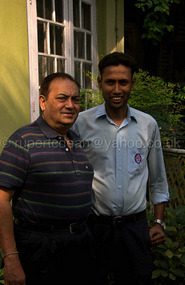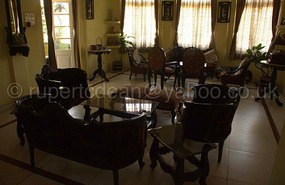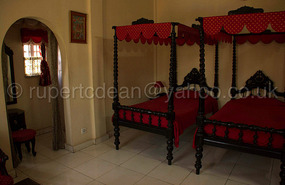The early morning sumo ride from Ziro to Itanager was slow, crowded and hot. The road construction dust was uncomfortable and I found myself longing for arrival some 60 mins before we got to the city outskirts. I checked back into the Blue Pine hotel and got my deluxe shared taxi ticket to Guwahati before meeting a smiling Bapu. I found a coffee bar and treated him to a coffee before telling him of my travels in Ziro Valley.
He then took me on his motorcycle to meet his uncle, an architect and his aunt who lived in a house next door
. Both were surprised to meet a foreigner and very hospitable with tea and nibbles. We then grabbed an early dinner before I said goodbye and went to bed. Up at 3.00am the deluxe taxi was suitably late, but at least I occupied the front seat in a new Suzuki and we left for Guwahati before anyone in Itanager had woken up. In fact the journey was remarkably easy and we only encountered traffic some three hours later on the outskirts of Guwahati.
Guwahti’s traffic was nightmarish and it took two hours to get from the outskirts to MC Road and Barauh Bhavan. It was good to be back and the weather was noticeably warmer, with temperatures in the late twenties which was quite a shock after the freezing temperatures and snow in the Dibrang Valley some ten days before.
I had returned to Guwahati to hopefully retrieve my new ATM card from the Indian Postal Service. It had been sent from Bristol some six days before, but as yet there was no sign in Guwahati. Never the quickest service, India Post is usually reliable for parcels if some what mind numbingly slow, but for a replacement ATM card - well I was taking a risk. Luckily I had a tracking number and whilst the internet speed in India is not usually conducive to tracking packages online, I was still hopeful in finding its location
. Unfortunately after several attempts the convoluted and complicated nature of the Post Office website defeated me. Consequently, I realised I might have more luck if I sat with a trained member of the Post Office staff.
Once I had managed to sort that problem out, I was then made aware that I had arrived in Guwahati on the last working day before the Hindu holiday of Holi (the famous two day spring festival). Suddenly I realised that the Post Office could be closed for 48 hours - I was somewhat panicked. At least I was now staying with Raj so the US$5 left in my pocket could remain there until my new card arrived and access to my money was resumed.
Luckily, whilst on the phone to Delhi’s Head Post Office I was informed that Guwahati would be working the next day, so I decided I needed help and Hari (Raj’s manager) put me on his motorbike and drove me to the local sorting office
. We parked outside and walked straight inside the sorting room. I was not expecting this as I thought there would be security to protect these registered parcels and post, but no there was nothing. Soon the staff were sorting through everything trying to find my letter. Unsurprisingly, computers were not employed in this search so after a good 40 mins, the foreman declared “it has not arrived”. Hari now started a search through the sorting office, the offices, the canteen, the managers’s office and various other attached buildings to try and find the right person to talk with. I trailed behind. Time and time again, the person to whom we had been directed turned out not to be the one responsible. Eventually we entered a door saying “speed post” and there, a man sitting behind a desk, in front of a computer casually informed me that the letter was in Kolkata - “where it has been for three or four days!”. It arrived in Delhi some five days ago where it was kept for two days before being sent to Kolkata.” It took just 15 hours to get from Bristol to Delhi - so I was perplexed as to why it had been sent all over the country and not to Guwahati and why was it in Kolkata for so long. However, I thought it was best to keep my mouth shut. At least it was on their system.
We managed to get the phone number off the unsmiling clerk, yet he was not going to let us use his desk phone. So Hari called the the Kolkata Manager of this “speed post” in Bengal on my mobile. That did the trick. After some time, the letter was identified and placed on a flight, due to arrive in Assam that night. Now I knew it would be ready for my collection the following day which was the day before the Post Office’s closure. I was relieved but still unwilling to celebrate with my last $5. Outside the Post Office Holi celebrations were now in full swing as seemingly the whole city took to the streets to water fight and spay coloured paints all over each other. Raj was obviously tipped off and fled to the hills in Shillong. I watched from a distance wondering whether to risk my camera and it all looked fine, but accidents do happen and where can one fix a Nikon here in the North East.
Exhausted I enjoyed a relaxing afternoon and an early night. Holy meanwhile went on and on. Even the Baruah Bhavan staff had changed out of their branded clothes when I returned so they could indulge in this huge colourful festival.
The following day the streets were coloured in greens, purples and orange paint stains. I again made my way back to the sorting office with Hari and to my immense relief, there was my letter. I treated myself to some lunch and then returned to Baruah Bhavan to plan my next destination.
One of my main reasons for coming back to the North East was to photograph some interesting birds, especially in Arunachal Pradesh. Unfortunately due to the enormous National Park fees introduced by the Arunachal Government for foreigners ($30 US per day) this activity is now one of the most expensive in the world. For example, Bharatpur is the most famous Birdlife national park in India and the charge is approximately $8 per day. Even the Amazon Basin Manu NP in Peru is only US $47 for seven days, Etosha in Namibia is just 6 US$ per day, Okavango Delta & the Kalahari National Park in Botswana is a paltry $2 per day and Kakadu National Park in Australia is $19 US for 14 days. Nevertheless despite these enormous fees, I still felt I could manage a quick visit to this sanctuary if I did not see another park in Arunachal Pradesh. Unfortunately I could not get hold of the Lama Camp in Eagle’s Nest, but my quote from the Bampu Camp in the National Park made rather depressing reading. This camp wanted R14,000 for my visit. This broke down as roughly R4,500 for my tent and meals, R8,500 for a hire car and driver (which they said was necessary to get to them in their emote location) plus the rest was guide, park fees etc). This daily fee was the equivalent of US $220 per day. This was obvious far in excess of what I can pay - so I immediately started rethinking. Of course these charges in India only apply to foreigners. A sort of tourist apartheid.
It was Raj who came to my rescue suggesting Nameri National Park in Assam near Tezpur. This park is good for birds, but not on a par with Eagle’s Nest. However several of the birds I wanted to photograph and most specifically the Great Hornbill where known in the park. The cost of the fixed tent accommodation was around $30 and the park fees of course were less than Arunachal’s, but still an expensive US$17 per day. I thought about it and agreed. Once I had found a vacancy, I was off.
I went to Tezpur the following day staying in the luxurious KPC Palace, one of the cleanest and nicest hotels I have been in India. Not the cheapest though, but much cheaper than visiting a national park in Assam. Amazingly the food in the restaurant (again whilst not cheap) was outstanding and some of the best I have had in India. So I had a relaxing night before setting off to the Nameri Eco Lodge.
Post Office, Hari's Help, Tourist Apartheid
Sunday, March 01, 2015
 Guwahati, Assam, India
Guwahati, Assam, India
Other Entries
-
92Island Life, Portuguese Colony, Christmas
Dec 2566 days prior Diu, Indiaphoto_camera4videocam 0comment 0
Diu, Indiaphoto_camera4videocam 0comment 0 -
93Restaurant Tombs, Mosques, Markets
Dec 2863 days prior Ahmedabad, Indiaphoto_camera5videocam 0comment 0
Ahmedabad, Indiaphoto_camera5videocam 0comment 0 -
94Birds, NYE, Dhows, Feral Dogs, Shaves
Dec 3160 days prior Mandvi, Indiaphoto_camera6videocam 0comment 0
Mandvi, Indiaphoto_camera6videocam 0comment 0 -
95Blue Moon, Salt Flats, Crafts
Jan 0258 days prior Bhujodi, Indiaphoto_camera5videocam 0comment 0
Bhujodi, Indiaphoto_camera5videocam 0comment 0 -
96Calico Musuem, Festival Prep, Street Life
Jan 0654 days prior Ahmedabad, Indiaphoto_camera5videocam 0comment 0
Ahmedabad, Indiaphoto_camera5videocam 0comment 0 -
97Leopards, Shepherds, Turbans and Aristocrats
Jan 1149 days prior Bhenswara, Indiaphoto_camera5videocam 0comment 0
Bhenswara, Indiaphoto_camera5videocam 0comment 0 -
98Birds, Fog, Bad Internet, Old Friends
Jan 1446 days prior Jodhpur, Indiaphoto_camera7videocam 0comment 0
Jodhpur, Indiaphoto_camera7videocam 0comment 0 -
99Tigers Tigers Tigers Tigers and oh Tigers
Jan 1743 days prior Sawai Madhopur, Indiaphoto_camera6videocam 0comment 0
Sawai Madhopur, Indiaphoto_camera6videocam 0comment 0 -
100Trains, Rodents, Rip offs, Delhi and Gentle
Jan 2535 days prior Delhi, Indiaphoto_camera3videocam 0comment 0
Delhi, Indiaphoto_camera3videocam 0comment 0 -
101Sand, Masks, Forest Man, Monks & Bamboo
Feb 0227 days prior Majuli, Indiaphoto_camera8videocam 0comment 0
Majuli, Indiaphoto_camera8videocam 0comment 0 -
102Julius, Gibbons, Park Fees, Tea & Gymkhana
Feb 0524 days prior Jorhat, Indiaphoto_camera5videocam 0comment 0
Jorhat, Indiaphoto_camera5videocam 0comment 0 -
103Houseboats, Dolphins, Rain and Animal Planet
Feb 1019 days prior Tinsukia, Indiaphoto_camera5videocam 0comment 0
Tinsukia, Indiaphoto_camera5videocam 0comment 0 -
104Tezu family home, TV Mike, Huts, Cows, River Wash
Feb 1415 days prior Tezu, Indiaphoto_camera5videocam 0comment 0
Tezu, Indiaphoto_camera5videocam 0comment 0 -
105Sumos, Boulders, Oranges, Idu Mishmi
Feb 1712 days prior Roing, Indiaphoto_camera5videocam 0comment 0
Roing, Indiaphoto_camera5videocam 0comment 0 -
106Motorbikes, Idu Mishmi, Hats, Illness, Scenary
Feb 1910 days prior Anini, Indiaphoto_camera9videocam 0comment 0
Anini, Indiaphoto_camera9videocam 0comment 0 -
107Nyokum Yullo, Nishi people, ferries, chain dance
Feb 227 days prior Itanagar, Indiaphoto_camera5videocam 0comment 0
Itanagar, Indiaphoto_camera5videocam 0comment 0 -
108Paddies, Plugs, Tattoos, Weddings, Bamboo, Spirits
Feb 245 days prior Ziro, Indiaphoto_camera5videocam 0comment 0
Ziro, Indiaphoto_camera5videocam 0comment 0 -
109Post Office, Hari's Help, Tourist Apartheid
Mar 01 Guwahati, Indiaphoto_camera3videocam 0comment 0
Guwahati, Indiaphoto_camera3videocam 0comment 0 -
110Hornbills, Eco Lodge, Birds, Elephants & Nameri NP
Mar 032 days later Tezpur, Indiaphoto_camera5videocam 0comment 0
Tezpur, Indiaphoto_camera5videocam 0comment 0 -
111Plans Changing, Bus tyres, early closing museums
Mar 087 days later Kohima, Indiaphoto_camera2videocam 0comment 0
Kohima, Indiaphoto_camera2videocam 0comment 0 -
112Wildlife, History, Bad Roads, Elephants & Dust
Mar 1312 days later Wokha, Indiaphoto_camera5videocam 0comment 0
Wokha, Indiaphoto_camera5videocam 0comment 0 -
113Wedding, More Dust, Shawls, Tensions and Sumi Food
Mar 2019 days later Zunheboto, Indiaphoto_camera3videocam 0comment 0
Zunheboto, Indiaphoto_camera3videocam 0comment 0 -
114Stones, Inventions, Old Friends and Shop 65
Mar 2423 days later Mokokchung, Indiaphoto_camera5videocam 0comment 0
Mokokchung, Indiaphoto_camera5videocam 0comment 0 -
115Meeting Mr Sosangtemba Longkumer Ao
Mar 2625 days later Longsa, Indiaphoto_camera4videocam 0comment 0
Longsa, Indiaphoto_camera4videocam 0comment 0 -
116Expensive Transport, Rain, Football, Cockroaches
Mar 2827 days later Longleng Nagaland, Indiaphoto_camera3videocam 0comment 0
Longleng Nagaland, Indiaphoto_camera3videocam 0comment 0 -
117Pork, Pigs, Moon Singing, Monsoon, Footy
Apr 0131 days later Wakching, Indiaphoto_camera10videocam 0comment 0
Wakching, Indiaphoto_camera10videocam 0comment 0 -
118Aoling Festival, Rain, Easter, Rain, Rain
Apr 0636 days later Wakching, Indiaphoto_camera10videocam 0comment 0
Wakching, Indiaphoto_camera10videocam 0comment 0 -
119The Not Super Travel Co, Tea, Temples & Bye Byes
Apr 1040 days later Kamakhya, Indiaphoto_camera5videocam 0comment 0
Kamakhya, Indiaphoto_camera5videocam 0comment 0 -
12035c, Haveli, Pink City, Amber Fort, Tigers, Tigers
Apr 1545 days later Sawai Madhopur, Indiaphoto_camera5videocam 0comment 0
Sawai Madhopur, Indiaphoto_camera5videocam 0comment 0 -
121Taj, Baby Taj, carpets, arguments, fever plus 43c
Apr 1848 days later Agra, Indiaphoto_camera5videocam 0comment 0
Agra, Indiaphoto_camera5videocam 0comment 0 -
122Mud, Mangroves, Kingfishers, Boats, Storms, Otters
Apr 2252 days later Sundarbans National Park, Indiaphoto_camera10videocam 0comment 0
Sundarbans National Park, Indiaphoto_camera10videocam 0comment 0 -
123Last Days in Kolkata, Obsolete Passports, Thailand
May 0161 days later Koh Chang, Thailandphoto_camera10videocam 0comment 0
Koh Chang, Thailandphoto_camera10videocam 0comment 0 -
124Getting home, reflections and thoughts
May 1373 days later Bristol, United Kingdomphoto_camera3videocam 0comment 3
Bristol, United Kingdomphoto_camera3videocam 0comment 3

 Guwahati, Assam, India
Guwahati, Assam, India





2025-05-22